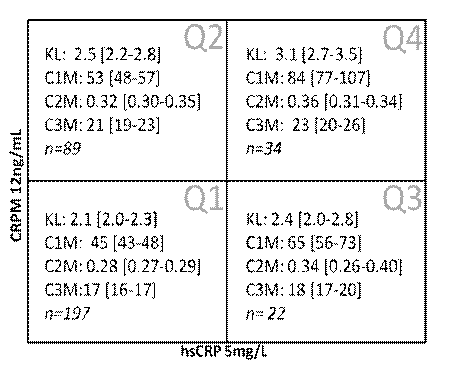Session Information
Session Type: Abstract Submissions (ACR)
Background/Purpose: In osteoarthritis (OA) it is evident that a subset of patients experiences chronic tissue inflammation and may benefit from anti-inflammatory treatment. The systemic inflammation marker C-reactive protein (CRP) has shown limited use in predicting disease severity, progression or response to anti-inflammatory treatment. The aim of this study was to investigate whether OA patients can be segregated into groups dependent on the present or absence of systemic and/or chronic tissue inflammation and whether such groups have different levels of MMP driven tissue destruction.
Methods: A cross-sectional study of 342 patients: 281 patients had symptomatic knee OA and no planned total knee replacement (TKR) and 61 who underwent TKR. Serological biomarkers were measured by ELISA: high sensitive CRP (hsCRP), CRP degradation fragment (CRPM, chronic tissue inflammation), MMP-mediated degradation fragments of type I, II and III collagen; C1M (connective tissue), C2M (cartilage) and C3M (synovium). The associations between biomarkers and OA stage were investigated: Kellgren & Lawrence (KL) 0, Mild OA (n=12); KL1-2, Moderate OA (n=202); KL3-4, Severe OA (n=57); and KL3-4 with TKR (n=60). Cut-off values of CRPM and hsCRP were set as 12ng/mL and 5µg/mL (mean+2SD of controls). Patients were divided in quartiles (Q, fig) based on the cut-off values. Reference values of the biomarkers were recorded for healthy controls. Data are shown as mean [95%-CI].
Results: hsCRP was only elevated with TKR (5.9 [3.6-8.2] µg/mL) compared to controls. In contrast, the mean levels of the CRPM were twice as high in the OA groups (10-14ng/mL) compared to controls (5ng/mL). C1M and C2M were significantly elevated in the TRKs compared to Moderate (p<0.001) and Severe (p<0.01). There was no difference between patient and controls in C3M. Patients in Q4 (fig) had significantly higher KL compared to patients in Q1 (p<0.0001), Q2 (P=0.017) and Q3 (p<0.0001). C1M, C2M and C3M were lower in Q1 compared to all other quartiles. Comparing Q2 with Q3 showed that C1M was higher (p=0.0005) in Q3, but C3M was lower (p=0.019). Thus, the populations identified by systemic and chronic tissue inflammation have different structural integrity.
Conclusion: All OA patients had surprisingly high levels of chronic tissue inflammation. OA patients could be divided into quartiles or 2 separate groups: i) those who may benefit from anti-inflammatory treatment (Q3, Q4) and ii) those eligible for a more tissue centric treatment (Q1, Q2). Patients with high CRPM (Q2 and Q4) had higher levels of the tissue degradation markers C1M, C2M and C3M suggesting that they had elevated tissue turnover. In alignment, those OA patients undergoing TKR had even higher levels of tissue turnover markers, suggesting a distinct TKR serological phenotype. Clearly different types of OA with different levels and types of tissue destruction could be identified by CRPM, but not CRP.
Disclosure:
A. S. Siebuhr,
Nordic Bisocience,
3;
K. K. Petersen,
None;
L. Arendt-Nielsen,
None;
L. Egsgaard,
None;
T. N. Eskehave,
None;
O. Simonsen,
None;
C. Christiansen,
Nordic Bioscience Diagnostic,
1,
Nordic Bioscience Diagnostic,
6;
H. C. Hoeck,
None;
M. A. Karsdal,
Nordic Biosciece,
1,
Nordic Bioscience Diagnostic,
3;
A. C. Bay-Jensen,
Nordic Bioscience Diagnostic,
3.
« Back to 2013 ACR/ARHP Annual Meeting
ACR Meeting Abstracts - https://acrabstracts.org/abstract/identification-of-osteoarthritis-patients-with-chronic-inflammation-driven-disease-progression/

